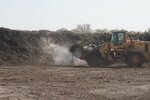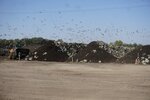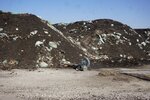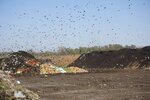Even before the beginning of November, the sight of jack-o-lanterns slowly decomposing on doorsteps is a common one. Hastings organic drop-off site is hosting an event to make it easier for residents …
This item is available in full to subscribers.
To continue reading, you will need to either log in, using the login form, below, or purchase a new subscription.
If you are a current print subscriber, you can set up a free website account and connect your subscription to it by clicking here.
Otherwise, click here to view your options for subscribing.
Please log in to continue |




Even before the beginning of November, the sight of jack-o-lanterns slowly decomposing on doorsteps is a common one. Hastings organic drop-off site is hosting an event to make it easier for residents to dispose of their pumpkins in an environmentally friendly way.
On Nov. 2-3 Hastings residents can drop off their pumpkins at the Hastings Transportation Shop located at 900 County Road 47. These pumpkins will be added to the organics and food waste drop off site located at the transportation shop where residents can normally drop off their food scraps, plant trimmings and non-recyclable paper products like paper bags, egg cartons and paper towels. Last year the program collected 84 tons of pumpkins across the county.
The Hastings organics drop off site opened in 2020, and nearly 800 Hastings households participate in the program generating around 2,800 pounds of organic waste each week, according to Dakota County Environmental Specialist John Exner.
Hastings participates in Dakota County’s Organics Drop Off program that contracts with organics recycling companies which are able to properly aerate, strain, and mix food waste and turn it into compost, topsoil and mulch that is able to be sold. Dakota County works with Specialized Environmental Technologies Inc. (SET) which owns and operates The Mulch Store out of Empire Township to do just that.
Just outside of Rosemount, SET’s Mulch Store is a dusty series of mounds of food waste, yard waste, top soil, sand, and the various other components that go into the creation of mulch and compost. Flocks of starlings and seagulls wheel over the site, picking at the food scraps only to flee the passing trucks and front loaders. The “24-hour buffet,” as SET Quality Control and Environmental Compliance Specialist Jake Duame called it, extends up the food chain, with eagles and turkey vultures passing further overhead.
SET processes around 20,000 tons of food waste annually. That food waste comes from restaurants, school districts, and city and county contracts. SET is one of two organic waste companies in the Twin Cities metro area, the other being the Shakopee Mdewakanton Sioux Community Organics Recycling Facility in Shakopee. SET works with the City of Minneapolis, Hennepin, Dakota and Carver counties, as well as many smaller businesses.
“Pretty much all of the organics in the Twin Cities comes to us,” said Duame.
The majority of Hastings’ and Dakota County’s food waste via the organics drop off program makes its way through SET’s process of turning table scraps into all manner of soil. While the process of turning food waste into mulch, topsoil and compost depends on the final product, most follow a similar pattern.
First food waste is grated to ensure that no more than 5% is not compostable material by volume. Duame says he often works with haulers to ensure that the load is able to be composted: “Basically, any time there are a lot of people composting there will be people that don’t know or don’t care.” If a load of organics is too full of trash, it can be rejected outright and sent to the dump, but that isn’t usually the case.
If the load of food waste meets SET’s standards, it is mixed with dry yard waste, often leaves stockpiled from the fall, and then laid in long piles over SET’s aerating system, a blower pushing air through a perforated tube throughout the pile. These piles are known as aerated static piles. Air is pushed through the piles in order to stimulate biological activity, mainly bacteria and fungi which carry out the decomposition process. Due to the aeration system, the piles don’t need to be regularly sifted. The piles get extremely warm inside, around 140 degrees Fahrenheit, due to the energy released from the decomposition process with temperatures carefully monitored by thermometers stuck into each pile.
After 45-60 days, the piles are sifted to further remove large pieces of organic material that would take too long to decompose along with other contamination from inside the pile. Afterword, the piles are again left alone for 3-6 months in a process called curing and finally grated one last time before being sold.
Despite that complexity, this process is quite similar to home composting piles.
“It’s not terribly different from that […] the biggest change is the sheer amount,” said Duame.
Composting is often seen as the cure-all for many environmental issues like overflowing landfills and trash never going away. To some extent that is true. Composting is a great way to save space in landfills because even when compostable material is thrown away, it often doesn’t ever break down because trash is compacted so tightly there is no air to allow fungi and bacteria to begin the decomposition process.
This lack of oxygen means that even if organic material breaks down in a landfill, it will often do so anaerobically, a process that releases methane and actually adds to greenhouse gases in the atmosphere.
While composting and organics recycling facilities like The Mulch Store undoubtably help reduce the quantity of trash and the efficiency of the facilities that work with it, Duame is doubtful that composting is the perfect solution: “As far as food waste issues, there’s not really a silver bullet to solve the issue.”
Duame points to upstream solutions of reducing the total amount of food waste as a better answer rather than the proliferation of organics recycling facilities. Reducing the amount of waste generated from grocery stores rotating their stock, restaurants throwing out foods, and general household organic waste would better answer the problem of food waste rather than being able to compost it on the back end.
Demand for expanded composting programs and therefore for organics recycling facilities has been growing for decades. When Duame started at SET eight years ago, the company’s limit for contamination of organics materials was 10% by volume, double what it is today, because the quality of compost was that low.
“The quality of food waste has improved dramatically in the last eight years,” said Duame citing the greater understanding and level of care in the state.
Despite that increased demand, it can be difficult for organics recycling facilities to open due to the heavy regulation put upon them. Organics recycling facilities are strictly regulated because of the nutrient-rich water that comes off compost piles that can cause algal blooms similar to fertilizer runoff from farm fields. The area SET uses for food waste is built upon a foot of compacted clay and is graded for water to flow into retention ponds which have to be periodically emptied by the water being taken to water treatment plants. “It is a difficult business,” says Duame.
In addition, organics recycling facilities can be odorous. The cloying scent of rot can reach the town of Coates more than a mile away from The Mulch Store if the wind is blowing the right way. While Duame and SET work closely with city officials to stop the smell if and when it reaches the town by covering the piles with mulch and various other methods, odor concerns are just another red-tape issue that can hinder the creation of other facilities.
Despite the regulation, the appetite for compost is only going to grow. In the Minnesota Pollution Control Agency’s Solid Waste Metropolitan Policy Plan 2022-2042, the agency requires municipalities to, “Make residential curbside organics collection available in cities with a population greater than 5,000 by 2030.” This mandated increase of availability for organics collection will undoubtedly increase the volume of food waste collected. As to how that increased volume of food waste will be recycled, be it at expanded operations at existing facilities or new facilities altogether or both, is unclear.
It is all too easy to not think or care about what happens to trash when it leaves the bin. In fact, so many of the systems surrounding waste disposal emphasize the idea that trash simply disappears once it is out of sight. The dense ecosystem of haulers, landfills, recycling plants, energy recovery centers and organics recycling facilities, however, is one we all participate in, whether we care about it or not. Duame called it “a whole kind of underworld of what happens when it leaves your driveway.”
Recycling and composting asks us to put thought into what happens when we throw something away. The processes emphasize that these items, be it the rind of a cantaloupe or the plastic sticker on it, will exist once we are done with them. And maybe that awareness is a good thing.
To join Dakota County’s organics drop off program, call 952-891-7557 or email organics@co.dakota.mn.us.
For more information about the program, visit https://www.hastingsmn.gov/residents/my-home/recycling-garbage-services/organics-drop-off